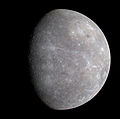Dosya:Mercury in color - Prockter07 centered.jpg

Orijinal dosya (1.991 × 1.974 piksel, dosya boyutu: 1,72 MB, MIME türü: image/jpeg)
Bu dosya Wikimedia Commons deposunda bulunmaktadır ve diğer projeler tarafından kullanılıyor olabilir. Aşağıda dosya açıklama sayfasındaki açıklama gösteriliyor.
|

|
This image was selected as picture of the day on Vietnamese Wikipedia.
|
Özet
| AçıklamaMercury in color - Prockter07 centered.jpg |
Русский: Полноцветное изображение Меркурия, полученное во время первого пролёта космического аппарата «Мессенджер». |
| Tarih | |
| Kaynak | NASA/JPL |
| Yazar | NASA/Johns Hopkins University Applied Physics Laboratory/Carnegie Institution of Washington. Edited version of Image:Mercury in color - Prockter07.jpg by Papa Lima Whiskey. |
| Diğer sürümler |
This file was derived from: Slightly different crop: File:Mercury in color - Prockter07-edit1.jpg |
- Original caption
MESSENGER's Wide Angle Camera (WAC), part of the Mercury Dual Imaging System (MDIS), is equipped with 11 narrow-band color filters. As the spacecraft receded from Mercury after making its closest approach on January 14, 2008, the WAC recorded a 3x3 mosaic covering part of the planet not previously seen by spacecraft. The color image shown here was generated by combining the mosaics taken through the WAC filters that transmit light at wavelengths of 1000 nanometers (infrared), 700 nanometers (far red), and 430 nanometers (violet). These three images were placed in the red, green, and blue channels, respectively, to create the visualization presented here. The human eye is sensitive only across the wavelength range from about 400 to 700 nanometers. Creating a false-color image in this way accentuates color differences on Mercury's surface that cannot be seen in black-and-white (single-color) images.
Color differences on Mercury are subtle, but they reveal important information about the nature of the planet's surface material. A number of bright spots with a bluish tinge are visible in this image. These are relatively recent impact craters. Some of the bright craters have bright streaks (called "rays" by planetary scientists) emanating from them. Bright features such as these are caused by the presence of freshly crushed rock material that was excavated and deposited during the highly energetic collision of a meteoroid with Mercury to form an impact crater. The large circular light-colored area in the upper right of the image is the interior of the Caloris basin. Mariner 10 viewed only the eastern (right) portion of this enormous impact basin, under lighting conditions that emphasized shadows and elevation differences rather than brightness and color differences. MESSENGER has revealed that Caloris is filled with smooth plains that are brighter than the surrounding terrain, hinting at a compositional contrast between these geologic units. The interior of Caloris also harbors several unusual dark-rimmed craters, which are visible in this image. The MESSENGER science team is working with the 11-color images in order to gain a better understanding of what minerals are present in these rocks of Mercury's crust.
The diameter of Mercury is about 4880 kilometers (3030 miles). The image spatial resolution is about 2.5 kilometers per pixel (1.6 miles/pixel). The WAC departure mosaic sequence was executed by the spacecraft from approximately 19:45 to 19:56 UTC on January 14, 2008, when the spacecraft was moving from a distance of roughly 12,800 to 16,700 km (7954 to 10377 miles) from the surface of Mercury.
Lisanslama
| Public domainPublic domainfalsefalse |
| Bu dosya NASA tarafından üretildiği için kamu malıdır. Aksi belirtilmediği sürece "NASA tarafından üretilen malzemenin telif hakkı olmadığı" NASA telif politikasında belirtilmiştir. (Bkz. Template:PD-USGov, NASA copyright policy page veya JPL Image Use Policy.) |  | |
 |
Uyarılar:
|
Orijinal yükleme günlüğü
This image is a derivative work of the following images:
- Image:Mercury_in_color_-_Prockter07.jpg licensed with PD-USGov-NASA, PD-USGov-NASA/copyright
- 2008-02-18T06:16:52Z Superm401 3000x2025 (1325745 Bytes) Reverted to version as of 01:42, 31 January 2008
- 2008-01-31T01:52:50Z Kwamikagami 2072x2025 (1091977 Bytes)
- 2008-01-31T01:42:24Z Kwamikagami 3000x2025 (1325745 Bytes) {{Information |Description=Full color image of Mercury from first MESSENGER flyby |Source=NASA/APL |Date=2008 Jan 30 |Author=NASA |Permission=public |other_versions=color version of [[Image:MESSENGER first photo of unseen sid
Uploaded with derivativeFX
| Annotations InfoField | This image is annotated: View the annotations at Commons |
Mozart
Qi Baishi
Raden Saleh
Hovnatanian
Raditladi
Kertész
Cunningham
Atget
Poe
Enwonwu
Xiao Zhao
Eminescu
Kunisada
Izquierdo
Tolstoj
Caloris Planitia
Neruda
Basho
Altyazılar
Bu dosyada gösterilen öğeler
betimlenen
30 Ocak 2008
image/jpeg
Dosya geçmişi
Dosyanın herhangi bir zamandaki hâli için ilgili tarih/saat kısmına tıklayın.
| Tarih/Saat | Küçük resim | Boyutlar | Kullanıcı | Yorum | |
|---|---|---|---|---|---|
| güncel | 12.49, 4 Haziran 2008 |  | 1.991 × 1.974 (1,72 MB) | wikimediacommons>Papa Lima Whiskey | {{Information |Description=Full color image of from first MESSENGER flyby |Source=NASA/JPL [http://messenger.jhuapl.edu/gallery/sciencePhotos/image.php?page=1&gallery_id=2&image_id=143] |Date=2008-01-30 |Author=NASA/[[w:Applied Physics Laborato |
Dosya kullanımı
Aşağıdaki 2 sayfa bu dosyayı kullanmaktadır:
Meta veri
Bu dosyada, muhtemelen fotoğraf makinesi ya da tarayıcı tarafından eklenmiş ek bilgiler mevcuttur. Eğer dosyada sonradan değişiklik yapıldıysa, bazı bilgiler yeni değişikliğe göre eski kalmış olabilir.
| Yönlendirme | Normal |
|---|---|
| Yatay çözünürlük | 300 dpi |
| Dikey çözünürlük | 300 dpi |
| Kullanılan yazılım | GIMP 2.4.4 |
| Dosya değişiklik tarihi ve zamanı | 14.42, 4 Haziran 2008 |
| Renk aralığı | sRGB |
| Resim genişliği | 3.000 px |
| Resim yüksekliği | 2.025 px |
| Dijitalleştirme zamanı | 17.34, 23 Ocak 2008 |
| Üst veri son değişim tarihi | 17.34, 23 Ocak 2008 |

